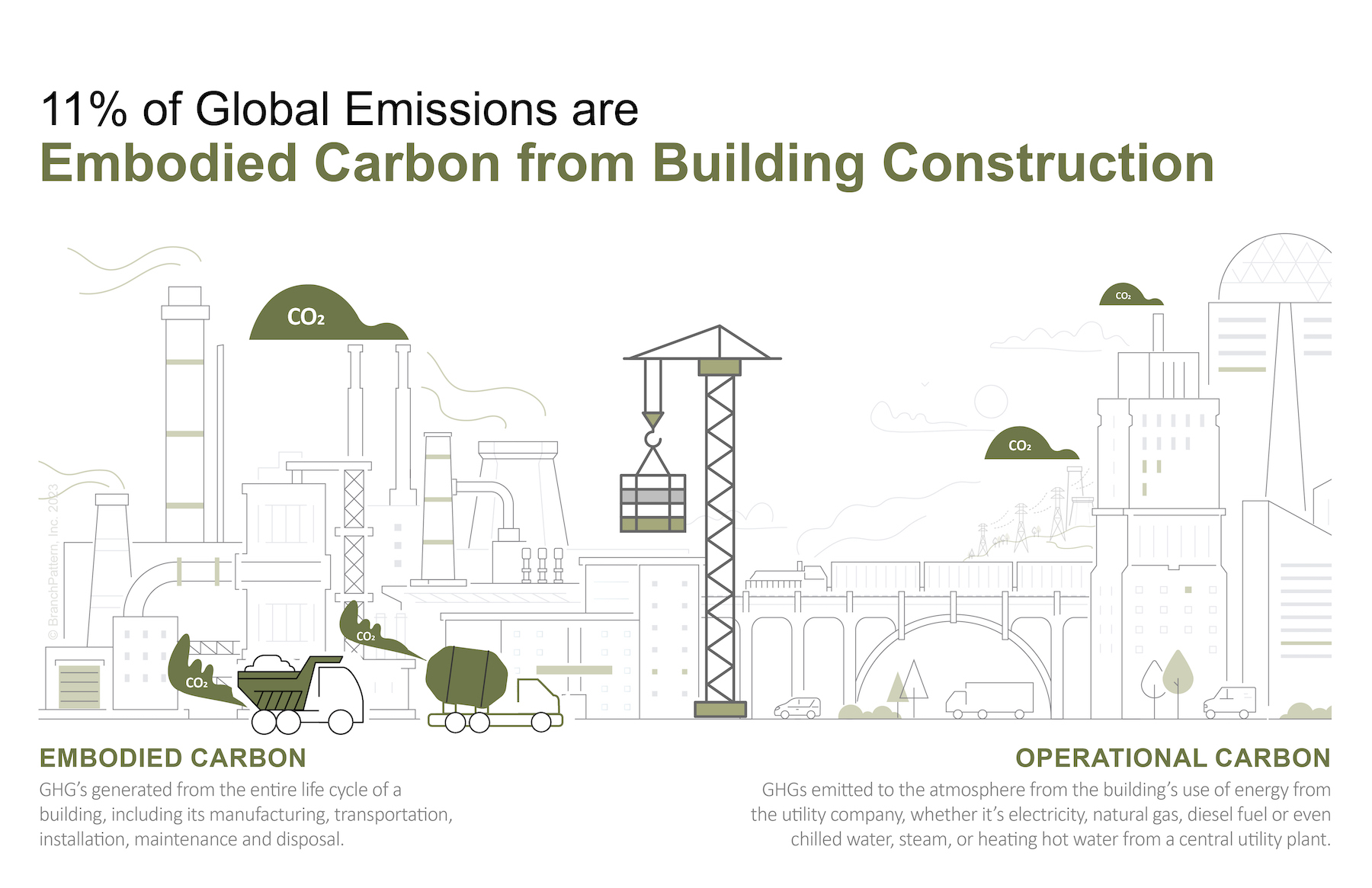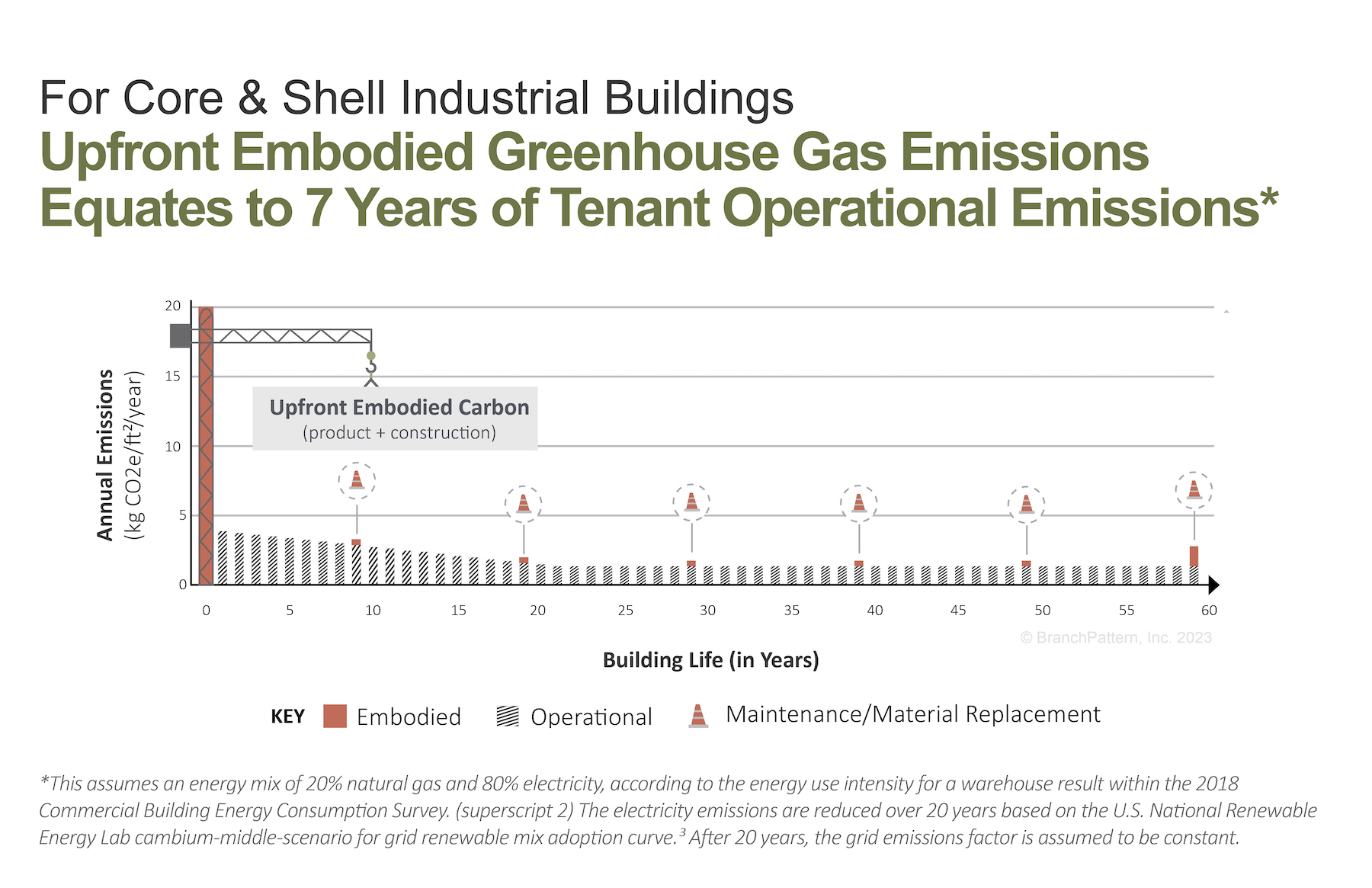The embodied carbon (EC) intensity in core and shell industrial buildings in the U.S. averages 23.0 kilograms per sf, according to a recent analysis of 26 whole building life-cycle assessments. That means a 300,000-sf warehouse would emit 6,890 megatons of carbon over its lifespan, or the equivalent of the carbon emitted by 1,530 gas-powered cars driven for one year.
Those sobering estimates come from a new benchmark study, “Embodied Carbon U.S. Industrial Real Estate,” which advocates for the measuring and reducing of EC in core and shell industrial buildings, one of the more vibrant commercial construction sectors.
The report was produced by BranchPattern, a Kansas City-based building consultancy dedicated to creating a better built environment. BranchPattern’s study partners for this report include Prologis, Brookfield Properties, IDI Logistics, Bridge Industrial, and Affinius Capital.

“We are at a pivotal moment for owners and developers of real estate to look beyond the greenhouse gasses emitted during building operations,” says Chris Brown, IDI Logistics’ Solar Development and ESG Director. “Working with industry peers, key partners, and suppliers to create pathways to lower carbon materials, design and construction techniques is an integral part of reducing the impact of buildings have in climate change.”
Building operations and building construction account for 28% and 11%, respectively, of global greenhouse gas emissions, according to the International Energy Agency. As buildings have become more energy efficient, operational carbon has been reduced. Therefore, addressing EC emissions “will become increasingly critical to meet climate goals,” states BranchPattern’s report, especially given that the global building area for industrial typologies is projected to double by 2050.
Right now, most of the available EC data are derived from lifecycle assessments of multifamily and office buildings. But based on conservative assumptions, EC is projected to account for 17.4% of a typical industrial building’s total emissions over 60 years. The report calls for greater access to EC measurement tools and comparative data that can help the industrial sector making informed design and construction decisions.

Stakeholders within an industrial building project have varying responsibilities and financial interests in reducing EC in their buildings. The developer, for example, makes decisions about building materials and design. The tenant, on the other hand, might participate in improvements that include MEP systems and interior finishes.
A small but telling sample
In 2022, BranchPattern conducted 46 lifecycle assessments, of which 26 for nine separate real estate developers or owners in six geographic regions of the U.S. are included in its report. The analyses were confined to Class A core and shell industrial warehouses of similar scope. The reference period for the lifetimes of the buildings was 60 years.
BranchPattern compared its EC intensity finding with a 2017 Carbon Benchmark Study of two buildings whose average EC intensity was 20.2 kg per sf.
The report concedes that its own sample isn’t large enough from which to draw definitive conclusions. “A larger, more robust dataset is required to determine regional variation with statistical significance,” the report states. That being said, BranchPattern’s study shows “a strong, positive, linear correlation” between a building’s size and its EC emissions.
The report finds that, on average, 55% of an industrial warehouse’s EC comes from its structure and enclosure, such as slab-on-grade, exterior walls, framing, and roofdeck. Consequently, an optimal EC reduction strategy addresses emissions from building materials like concrete and steel, which alone account for 11% and 10%, respectively, of global greenhouse gas emissions. For example, cement accounts for about 80% of the carbon emissions from a traditional concrete mix. Switching that mix from 100% ordinary Portland Cement to 50% fly ash/slag cement could reduce the mix’s carbon footprint by approximately 40%.

Buildings might also be designed to reduce their overall concrete volume via alternate wall assemblies or insulated metal panels. BranchPattern’s report estimates that substituting mass timber for steel or concrete assemblies would reduce the carbon footprint from the building’s structure/enclosure by 50%. (Affinius Capital recently completed a 161,200-sf Class A warehouse with mass timber, resulting in a 60% reduction in EC compared to a concrete build.) Even using Electric Arc Furnace-produced steel instead of basic oxygen furnace-produced steel cuts EC emissions by 40% to 60%.
Electric Arc Furnace steel is more likely to have a higher recycled content. Recycled materials in general typically have lower EC than virgin materials. However, the report observes that conventional demolition is still cheaper than recovering materials, especially wood. “A building designed for disassembly may have greater residual value, as the integrity of more materials is preserved.”
A call to action

The Paris Climate Accords have set a goal of reducing greenhouse gas emissions 40% by 2030, compared to 1990 emissions. To achieve that goal, “we must now focus on embodied carbon,” the BranchPattern report states. That will require transparent and clear carbon accounting methods that support stakeholder engagement. “To reduce, we must measure,” asserts the report.
Government funding and policy changes are increasing the development and implementation of low-carbon construction solutions. Green building certification programs “will continue to play a significant role mainstreaming embodied carbon knowledge within various building sectors,” the report predicts. The availability of lower-carbon materials will increase and be cost competitive. Engineering solutions in areas like carbon capture, utilization and storage will advance.
“Embodied carbon related emission reductions are possible, necessary, and promising,” the report concludes.
Related Stories
| Mar 12, 2014
14 new ideas for doors and door hardware
From a high-tech classroom lockdown system to an impact-resistant wide-stile door line, BD+C editors present a collection of door and door hardware innovations.
Sponsored | | Mar 10, 2014
A high-performance barn
Bastoni Vineyards replaces a wooden barn with an efficient metal building used for maintenance, storage, and hosting events.
| Mar 7, 2014
Chicago's 7 most threatened buildings: Guyon Hotel, Jeffrey Theater make the list
The 2014 edition of Preservation Chicago's annual Chicago's 7 list includes an L station house, public school, theater, manufacturing district, power house, and hotel.
| Feb 24, 2014
First look: UC San Diego opens net-zero biological research lab
The facility is intended to be "the most sustainable laboratory in the world," and incorporates natural ventilation, passive cooling, high-efficiency plumbing, and sustainably harvested wood.
| Feb 14, 2014
Must see: Developer stacks shipping containers atop grain silos to create student housing tower
Mill Junction will house up to 370 students and is supported by 50-year-old grain silos.
| Feb 13, 2014
Extreme Conversion: Nazi bunker transformed into green power plant, war memorial
The bunker, which sat empty for over 60 years after WWII, now uses sustainable technology and will provide power to about 4,000 homes.
| Feb 12, 2014
First Look: Futuristic Silicon Valley campus designed to draw tech startups
The curved campus will consist of four different buildings, one exclusively for amenities like a coffee bar, bike shop, and bank.
| Feb 7, 2014
Zaha Hadid's 'white crystal' petroleum research center taking shape in the desert [slideshow]
Like a crystalline form still in the state of expansion, the King Abdullah Petroleum Studies and Research Center will rise from the desert in dramatic fashion, with a network of bright-white, six-sided cells combining to form an angular, shell-like façade.
| Jan 28, 2014
16 awe-inspiring interior designs from around the world [slideshow]
The International Interior Design Association released the winners of its 4th Annual Global Excellence Awards. Here's a recap of the winning projects.
| Jan 13, 2014
Custom exterior fabricator A. Zahner unveils free façade design software for architects
The web-based tool uses the company's factory floor like "a massive rapid prototype machine,” allowing designers to manipulate designs on the fly based on cost and other factors, according to CEO/President Bill Zahner.

















